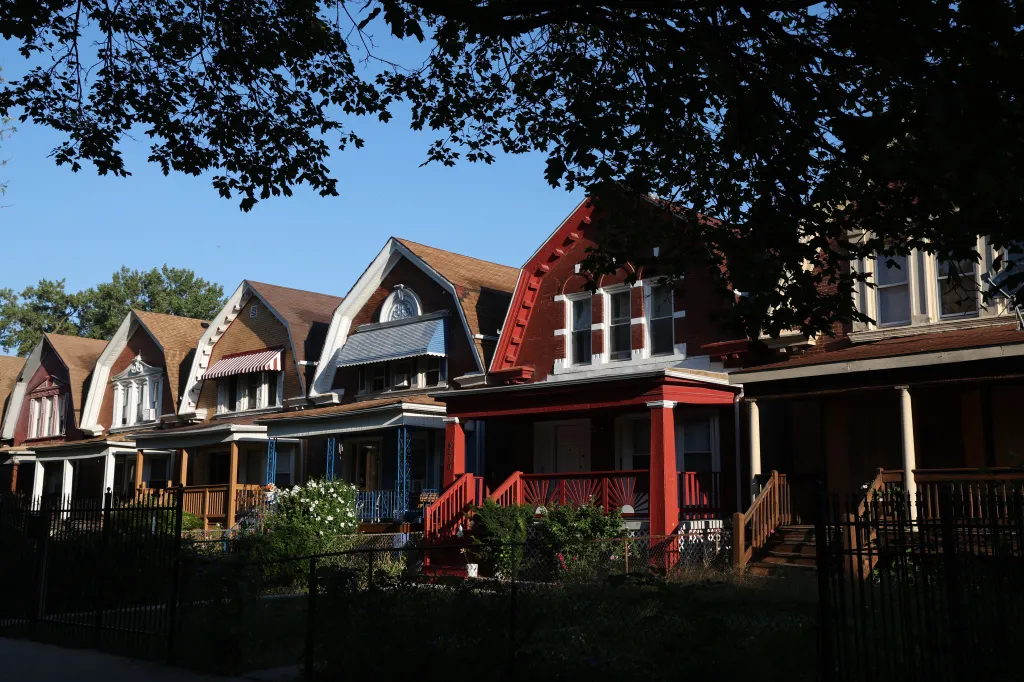
This story is a collaboration between the Illinois Answers Project and the Chicago Tribune.
Leodus Thomas Jr. sees a brighter future for Chicago’s West Side. It’s why, after buying his house in Austin nine years ago, he decided to become a developer.
But in the last several years, a new threat has emerged.
“We find (distressed properties) and get them back on the tax roll — but lately we’ve been punished for that — big-time,” Thomas said. Rising investment in the area has triggered rising property assessments, which in turn will likely result in higher property tax bills.
Thomas bought his red brick, two-story home in 2016 for $135,000. Two years ago, the Cook County assessor’s office pegged its value for tax purposes at about $163,000.
Last year, he got a new valuation: $260,000. That will translate to about a $700 hike on his annual tax bill compared to last year, according to an analysis by Illinois Answers Project and the Chicago Tribune.
It makes sense for taxes to increase gradually to meet the market, Thomas said. But the looming shock this year to his home and other investment properties will hurt his ability to invest more in future developments.
“Coming from the top, they want affordable housing in the city,” Thomas said. “But that’s almost impossible with how we’re being taxed.”
Thomas saw a nearly 60% increase in his assessment, but it could have been a lot worse, given what’s happening to many of his neighbors. More than 37,000 residential properties on the South and West sides saw their tax assessments more than double between 2023 and 2024. In parts of Englewood, Roseland and just east of Thomas in North Lawndale, the median homeowner saw their valuation increase between 119% and 160% — far more sharply than anywhere else in the city, according to the Illinois Answers and Tribune analysis.
The median Chicago homeowner saw their assessment increase by about 22% during the same cycle. Mayor Brandon Johnson, who lives about 2 miles north of Thomas in Austin, saw his home’s assessment climb about 35%.
Such stark increases are expected to leave many homeowners in those neighborhoods struggling to pay their tax bills this fall. And while their home values have increased significantly, they still lag behind most city neighborhoods. So, these homeowners ask, even if they sold, what other neighborhoods could they afford? Homeowners in the city’s lowest-income neighborhoods also are the least likely to take advantage of one key tool to soften property tax blows — appealing their assessments — one recent study showed.
The rest of Chicago tells a different story. Some of the wealthiest areas, including some that saw big hikes in previous years, saw the smallest increases this time. The Gold Coast, for instance, saw a 3% assessment hike.
The Tribune and Illinois Answers based their analysis on the assessor neighborhoods, which don’t overlap directly with Chicago community areas.
Pressure on taxpayers is only likely to intensify as fiscal crises continue at Chicago Public Schools — the biggest portion of Chicagoans’ property tax bills — and the city of Chicago. Smaller taxing bodies such as the Chicago Park District and Metropolitan Water Reclamation District have also hiked their levies in recent years.
A 100% assessment increase doesn’t mean a tax bill will double. How much these homeowners’ property bills increase will not be clear until tax bills are calculated and sent out later this year. But Scott Smith, the chief of staff to Cook County Assessor Fritz Kaegi, acknowledged, “Generally speaking, if you are seeing above-average increases in assessments, that is where there is a risk of bigger tax bill increases.”
The rule of thumb, Smith said, is that properties with increases above the citywide median — roughly 22% for residential properties — are likely to see their bill go up.
The increase appears especially dramatic because Kaegi lowered the assessments of many of those neighborhoods during the last city reassessment in 2021. It was his first opportunity to reverse what outside studies found were consistent overassessments of lower-value homes. The assessed value of homes in Englewood dropped by 34% and median tax bills dropped from $1,308 to $677 during that cycle. In West Garfield Park, home assessments fell by 32% and median residential bills dropped from $2,441 to $1,345.
Kaegi’s office — which is legally required to assess properties at their fair market value — said today’s values mirror sales activity in those neighborhoods. That includes purchases from speculative investors looking for affordable lots to build on or older homes to renovate.
“This is a signal of gentrification that is already happening,” Smith said. He called it an echo of the real estate speculation that turbocharged assessment spikes in Pilsen during the 2021 reassessment, and in Logan Square during the cycle before that.
New assessments are factored into bills the following year. Different parts of the county are assessed every three years, so without action, that assessment number will stay the same for the next two years.
Tools such as exemptions and appeals can soften the blow for some homeowners, especially seniors.
Clarence Hunt Jr., 70, a retired CTA train operator, saw the assessment on his West Garfield Park home nearly triple to $174,000 between 2023 and 2024.
He could have been in for a bill of about $1,750 if he hadn’t locked in the senior freeze exemption in 2023. That exemption will ensure that when it comes time for bills to be calculated, Hunt’s home value will stay at the 2023 assessment rate: about $60,000. With that freeze, plus other breaks for homeowners and seniors, his bill will likely be $0.
That means Hunt, who’s still paying off a mortgage on his home, can stay put on his fixed-pension income.
“I’m not leaving this house until they throw dirt on my face,” Hunt said.
Signs of gentrification
After the 2021 reassessment, many Pilsen homeowners revolted when their sharply higher taxes came due in 2022. According to the Cook County treasurer, the median residential tax bill in the Lower West Side community area that includes Pilsen went up by about 46% that year. In Logan Square, the median bill jumped by $1,338.
But Pilsen was largely spared under Kaegi’s 2024 reassessment. The median home value of the assessor neighborhood covering much of Pilsen only increased by about 3% between 2023 and 2024. Assessments in the Logan Square area jumped by about 12% during the same period.
Assessor neighborhoods covering Englewood, Garfield Park and North Lawndale still have some of the lowest overall assessed values in the city. The neighborhoods have some of the highest poverty rates in the city, having never fully recovered from the white flight and disinvestment that began in the 1960s.
But Kaegi’s staff said they’re starting to see dramatic price shocks that signal a potential start of gentrification.
“Especially since the pandemic, prices in South and West side neighborhoods have gone up quite a bit compared to the rest of the city,” said Geoff Smith, executive director of the Institute for Housing Studies at DePaul University.
The growth is driven in large part by investors flocking to the shrinking number of city neighborhoods where real estate is still affordable, Smith said.
The boom is evident in both public and private sales data.
Between 2016 and 2018, the median sale price for a residential property in central Englewood with six units or fewer was less than $26,000, according to an analysis of deeds by Illinois Answers and the Tribune. Between 2022 and 2024, it jumped to $95,000.
Other South and West side neighborhoods followed similar trends.
The listing service Zillow’s estimate of average home value jumped in North Lawndale from about $84,000 in May 2015 to $204,000 a decade later. During the same period, the Roseland neighborhood saw a spike from about $48,000 to nearly $128,000.
Rising values might increase homeowners’ personal equity, in some cases reflecting a return to pre-2008 recession levels, and can help attract businesses to move into the neighborhood. It’s a cause multiple nonprofits have been pushing for.
Ronda, 62, a retired city worker who declined to provide her last name for privacy reasons, said she had to start blocking calls from unknown phone numbers, given how often she was getting offers on her home on the West Side. But the simmering real estate market offers little comfort to her and other longtime homeowners who are in line for tax hikes but have no plans to sell.
“Even if I did sell, where would I go?” she said.
Ronda bought her squat worker’s cottage for $9,000 in 1990. Even though she hasn’t renovated it, the home’s assessed value has fluctuated from $132,400 in 2020 to $55,000 in 2021, a number that stayed static in 2022 and 2023. Last year, a fresh reassessment of the city pegged her home’s new taxable value at $151,000. This fall’s upcoming bills will be the first ones to factor in that significant hike.
“It’s BS,” Ronda said of the eye-popping assessment hike and likely coming tax increase. Like others, she believed she wasn’t getting what she paid for in terms of government services. “I’m still looking at the same potholes I’ve been looking at since I was 28.”
Ri Prasad, a real estate agent and developer active in Englewood, said a rash of recent city-backed programs designed to attract development in the area appear to be paying off. Realtors “saw an influx of buyers wanting to go where there’s affordability and looking for space” after those programs began taking hold, Prasad said.
Chicago sold vacant lots and abandoned homes for pennies on the dollar and gave out grants for land remediation. The Cook County Land Bank Authority offered fixer-upper homes at below-market prices in neighborhoods across the county. And Mayor Lori Lightfoot targeted many of those communities as part of her Invest South/West program.
Community-based nonprofits jumped at the opportunity to build on the city lots, typically buying them for a nominal $100, county sales data shows.
“Once those sale prices started hitting in the comps, that invited investors who weren’t seeing large profit margins in other areas to come and buy up these properties and then gut them,” Prasad said.
Many of the properties qualified for mortgage assistance or Veterans Affairs loans, letting buyers pay 3.5% or 5% down payments — rather than the standard 20%. Developers thought, “OK, if I get in now, this is going to be the (next) West Loop,” Prasad said.
The Tribune and Illinois Answers examined more than 5,000 property sales between 2022 and 2024 in the six neighborhoods that saw the highest residential assessment jumps. Roughly 1 in 5 sales there had a buyer with “LLC” or “corp” in its name — often, but not always, a sign of an institutional investor. Forty-seven of those buyers bought three or more properties in those neighborhoods during that period.
One of the buyers, an LLC that traces back to developer Brian Urbanowski of URB Inc., describes itself on its website as being at the “forefront of the Chicago South Side real estate market by optimizing the buying and selling process.”
That LLC, Illinois Land Investment Inc., purchased 20 properties in those six neighborhoods for an average sale price of about $29,000. Urbanowski was previously investigated by the Illinois attorney general’s office for complaints related to his company’s installment land contracts. During the investigation, the state passed new regulations for such contracts. Urbanowski’s company was “brought into compliance,” and the investigation was ultimately closed, according to attorney general spokeswoman April McLaren. The company has not faced new complaints in the last five years, according to the attorney general’s office.
“Although significant assessment increases and property tax hikes have minimal impact on his business, Mr. Urbanowski remains mindful of their broader implications — particularly how they may discourage homeownership in Chicago,” a spokesperson for Urbanowski wrote in an email.
Growing interest from investors may be driving up property values and inviting new development after decades of neglect, but that doesn’t make it a welcome sight to neighbors, according to Richard Townsell, executive director of the nonprofit Lawndale Christian Development Corp.
LCDC built 75 homes last year and bought — or partnered with other organizations to buy — more than two dozen properties in recent years in the South and West side neighborhoods with the biggest assessment jumps. Many were $100 vacant lots or abandoned properties where the organization built new, affordable housing.
Townsell said he was frustrated to see outside investors scooping up properties to wait for the neighborhood to become more valuable, instead of building for locals.
“We’re selling (homes) to folks who are thinking about, ‘Is this a place where I want to live, where I want to raise my family, where I want to support the businesses that are here?’” Townsell said. “When you have outside investors, they don’t care. … it’s just a number.”
Both Prasad and Erika Villegas, president of the Chicago Association of REALTORS, said it’s unfair that other homeowners have to pay the price through higher property taxes.
“You see somebody rehabbing a property and selling it for $300,000 and some of the neighbors are worried about, ‘What’s going to happen if that house sells for $300,000? One, is my home worth that much? And then am I going to have to pay more taxes because of it?’” Villegas said. Not everyone has the ability or money to renovate their home, “especially when you have a long-term owner that has a cap on their income,” she added.
Sales are key to how Kaegi’s office calculates its assessments. Instead of individually examining each home every three years, the office combines property characteristics — like a home’s age, its construction material, and its size — with sales data from the surrounding neighborhood to train its valuation models.
Smith, Kaegi’s chief of staff, said the office has been working to eliminate sales from its model that aren’t “arm’s length” — such as a discounted sale between family members or a sale of several properties between two LLCs — that don’t match “real market activity.” The office investigates property sales that seem atypical for a neighborhood. Officials may then exclude the sale from their model or catch significant renovations to a home they may have missed.
As an example, Smith pointed to a six-flat in Englewood that the office’s algorithm flagged because it sold for more than $1 million last year after selling for a fraction of that price a few years earlier. After some digging, officials found it was part of a multiparcel transaction.
To Townsell, the soaring assessments show Kaegi’s team didn’t strike enough high-dollar sales from their model.
“When … hedge funds run up, go $100,000 over the asking price, or whatever they’re doing to artificially run up the market, what do we do about that?” Townsell said.
Alarms loud enough?
The assessment jumps may shock homeowners, but Smith said Kaegi’s office has been trying to warn residents and local politicians about the increases since the data started showing up in last year’s revaluation.
“We did more outreach in Chicago than we ever have,” Smith said. That included briefings for aldermen, county commissioners and state legislators ahead of the release of assessments for each township, then post-assessment outreach in each township for home and business owners. In all, the assessor’s office said it hosted 218 events for homeowners. Roughly half were held in the city townships that saw the biggest assessment jumps.
“We know that aldermen don’t want to be surprised by these assessments,” Smith said. “These are areas where you need to make sure people are getting exemptions. These are areas where people need more appeal outreach.”
Still, few aldermen are bracing for the kind of taxpayer backlash that gripped Pilsen in 2022 and south suburban Cook County last year after reassessments there skyrocketed.
The median residential assessment in the assessor neighborhood covering much of Roseland increased by 123% between 2023 and 2024, data show.
But Ald. Anthony Beale, 9th, whose ward includes that area, said he hadn’t been hearing about worries from constituents earlier this spring. Seniors, in particular, “would have been jumping up and down,” he said.
Ald. Raymond Lopez, 15th, who represents part of West Englewood, said the assessor is right to catch the booming real estate market in the area.
“When I was first elected (in 2015), a vacant house would run you $5,000 cash,” Lopez said. “We have seen over the last 10 years…that vacant properties have increased sixfold in their value.”
Kaegi’s failing, Lopez said, has been a lack of outreach to warn homeowners and to point them toward appeals and exemptions. The office countered that it has also mailed out booklets and postcards reminding seniors and residents in affected neighborhoods about their exemptions, spokesman Christian Belanger said. And it plans to host more appeal events in those neighborhoods this year.
“The county really needs to do a job educating folks,” Lopez said. “Oftentimes we find, sadly, individuals who have gone 10, 15, 20 years without getting some of the discounts and savings that they’re entitled to.”
In addition to workshops with aldermanic offices, the assessor’s office sent a presentation in July 2024 to multiple South and West side elected officials, including Lopez, alerting them to the coming assessment hikes and urging them to make homeowners aware of exemptions.
While Kaegi’s office appears to have communicated frequently with politicians and homeowners, its language can be less than blunt.
Homes north of 71st Street saw “significant increases in sales, rehabs, and gentrification,” the PowerPoint presentation noted, encouraging those homeowners to file appeals before last September’s deadline.
The presentation referred to assessment increases as “growth in value” and emphasized that exemptions could help mitigate big assessment hikes.
The assessor’s office also held streaming workshops on Facebook and YouTube for residents to hear about the assessment process, learn their avenues for appeal and ask questions. But the figures shared in the briefings only touched on broad township-level data, with no specific warnings about the drastic jumps in specific neighborhoods.
The office similarly did not express the full impact of assessment increases on people’s bills.
“If you believe … the value that we placed on your home is overvalued, I urge you to file an appeal,” one of the office’s staffers told viewers in an online September session, referring them to the assessor’s data dashboards to see how their properties compared with others in the neighborhood.
“My assessment for a single-family home went from 74000 to 194000 with no improvements,” one commenter wrote during the session. “If my appeal is not won, will my tax bill triple too?”
The office responded that “the value makes up one portion of your whole tax bill. The treasurer’s office takes 10% of it to calculate your tax bill,” before referring them to a general explainer page.
Belanger said the streaming workshops were designed to present a broad overview, and that it would have been premature to project homeowners’ bills a year in advance.
For the better part of a year, Kaegi’s been touting a proposal he says could offer relief to the homeowners who are most vulnerable to dramatic tax hikes. His “circuit breaker” bill would give homeowners who saw tax bills spike by 25% or more an income tax credit to help cover part of the spike.
But the proposal has stalled in Springfield, in part because Kaegi estimates it would cost the state roughly $200 million in income tax or other revenues. Legislators, facing their own budget crunch and fiscal crises in other governments, did not take it up.
Kaegi also blames the county’s Board of Review for failing to do outreach and for broadly shifting the county’s property burden from business owners to homeowners. For last year’s Chicago reassessment, Kaegi’s office determined homeowners’ share of property value in Cook County was 49%, while commercial and non-residential made up 51%. But the county’s Board of Review, after appeals, reduced commercial values, bringing the homeowner share up to 54%.
The board has long argued Kaegi has over-assessed commercial properties such as warehouses, offices and stores. An outside study commissioned by the county found that Kaegi set the value of those properties too high during the last reassessment of Chicago in 2021 and that appeals brought them down closer to their sales price.
A separate study published this spring by the Cook County treasurer’s office found that South and West side homeowners have caught the short end of the Board of Review appeals process. The study tallied nearly $2 billion in property taxes shifted from commercial property owners to homeowners due to Board of Review breaks given between 2021 and 2023 alone. What’s more, lower-income homeowners are less likely to apply to the board to reap their own share of reductions.
“As a result, the appeals process added regressivity to the property tax system, meaning people with lower incomes shouldered a disproportionate share of the burden,” authors of the study wrote. “Appeal disparities also help explain why low-value homes often are assessed at higher percentages of their actual value than more expensive homes.”
George Cardenas, one of three commissioners on the board, noted the board can grant appeals only to those who applied. His staff noted that Kaegi’s burden shifting analysis doesn’t account for what value shifts back after homes receive their exemptions. But he acknowledged appeal rates in lower-income neighborhoods were low.
But Cardenas said there were other structural problems: property owners have only a small window to file their appeals. The county doesn’t clearly note venues for appeal or the potential for missed exemptions on bills. Thanks to new state legislation, the treasurer will include information about exemptions, including contact information for the assessor, on this year’s second-installment bills.
The board is requesting more resources for outreach in its upcoming budget, and all three commissioners urged property owners to file their appeals before the Board of Review starts looking at their township.
Thomas, the West Side developer, said he depends on the appeal process to make sure he isn’t taxed unfairly on his investment properties. But he likened the county to a dumpster company that raises rental prices when customers stop paying enough attention to ask for discounts.
“All of the properties’ taxes have shot up through the roof,” Thomas said. “You might win an appeal. But they’re just going to go right back up.”



